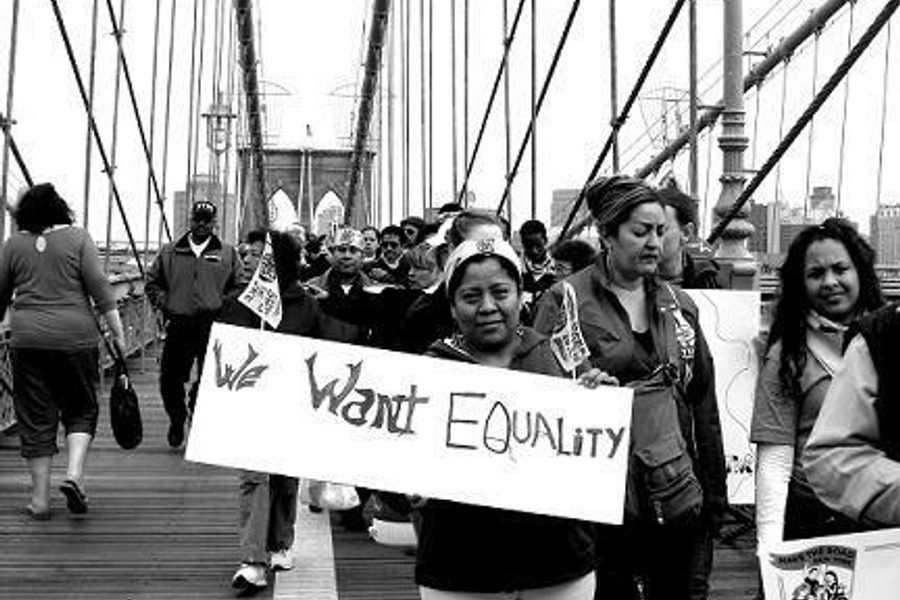
If you’re one of about 317,000 unlucky New Yorkers, there’s a good chance your boss screwed you this week. The average low-wage worker in the city loses approximately $58 a week — a total loss of more than $3,000 a year — thanks to employers who see cheating their workers as part of the cost of doing business.
According to a new report by the National Employment Law Project (part of a comprehensive study of low-wage workers in New York, Los Angeles and Chicago) about one in five surveyed workers in New York City reported that in the past week, they had been “paid less than the legally required minimum wage.” Of those who had worked more than a 40-hour week, nearly 80 percent were not paid for overtime. Overall, “More than half (54 percent) of our sample experienced at least one pay-related violation in the previous workweek.”
All those abuses add up over a worker’s lifetime. This week, a Queens supermarket was forced to pay about $300,000 in back wages and penalties after the state discovered that the employer had withheld pay from grocery baggers, leaving them only tips from customers, over a three-year period.
A similar survey in Los Angeles County, published earlier this month, showed that a whopping 9 in 10 surveyed workers, many of them undocumented immigrants, had recently experienced some form of wage theft.
The workers in the New York City study reported being robbed not only of their pay, but their rights. Many said they faced retaliation from employers after attempting to complain about working conditions or to organize fellow employees. Intimidation tactics included threats about calling immigration authorities or just firing workers.
The chilling effect runs deep. Workers often opted not to challenge employers “even though they had experienced a serious problem such as dangerous working conditions or not being paid the minimum wage.” About 40 percent feared they’d lose their job, or “thought it would not make a difference.”
And in many cases, they’d be right. An analysis of National Labor Relations Board data by the Center for Economic and Policy Research “illegal firings of pro-union workers” had trended upward in recent years, and “almost one-in-five union organizers or activists can expect to be fired as a result of their activities in a union election campaign.” Those findings underscore the need for legislation like the Employee Free Choice Act to ward off unionbusting.
Structural barriers and discrimination set the stage for abuse. Gendered occupations, such as domestic childcare workers and housekeepers, suffered especially high rates of minimum-wage violations, as do immigrant laborers and workers of color. A staggering four in ten undocumented women workers reported suffering a minimum-wage violation.
To strengthen protections for low-wage earners, the study recommended measures like boosting Labor Department funding to offset past cuts, helping injured immigrant workers obtain workers’ compensation, and strengthening state and even local minimum laws. Ensuring that workers understand their rights is also critical. A 2006 survey by the Brennan Center for Justice found that “the large majority of workers in New York City” didn’t know the state minimum wage.
In addition to regulatory enforcement, informal sector workers need proactive legislation to give them full legal recourse against employers. Pending legislation for a Domestic Workers Bill of Rights, for example, would provide baseline standards and protections, filling longstanding gaps in the federal regulatory regime.
Yet in contrast to the anemic inefficiency of the federal Department of Labor under Bush, New York’s Labor Department has been relatively successful, according to the NELP. Since 2007, the Department has set up special divisions to deal with immigrant workers and to address the misclassification of employees as independent contractors in order to skirt labor codes. Last year, the Department partnered with community groups to launch “wage watch”, an outreach initiative that engages local workers in workplace auditing and investigations. The Department also recently raised penalties for retaliatiing against workers who complain about employer abuse.
Nonetheless, even as underfunded regulators scramble to catch crooked employers, the frayed safety net isn’t keeping up with the expanding the ranks of the working poor. The deep unemployment crisis and intensifying desperation are pulling more and more Americans toward low-wage sectors. (New York’s Labor Department recently reported that wage violations have risen during the recession.)
The situation could worsen as the Obama administration moves forward with a controversial proposed spending freeze, which could potentially erode funding for the federal Department of Labor.
Labor authorities can play an indispensable protective role, but they won’t overcome the epidemic of wage theft if workers are not empowered to protect themselves as well — through robust unions, equal treatment for immigrants, and public workforce investment programs in poor communities. In the end, the best defense against labor exploitation may simply be a good job.
Michelle Chen is a contributing writer at In These Times and The Nation, a contributing editor at Dissent and a co-producer of the “Belabored” podcast. She studies history at the CUNY Graduate Center. She tweets at @meeshellchen.








